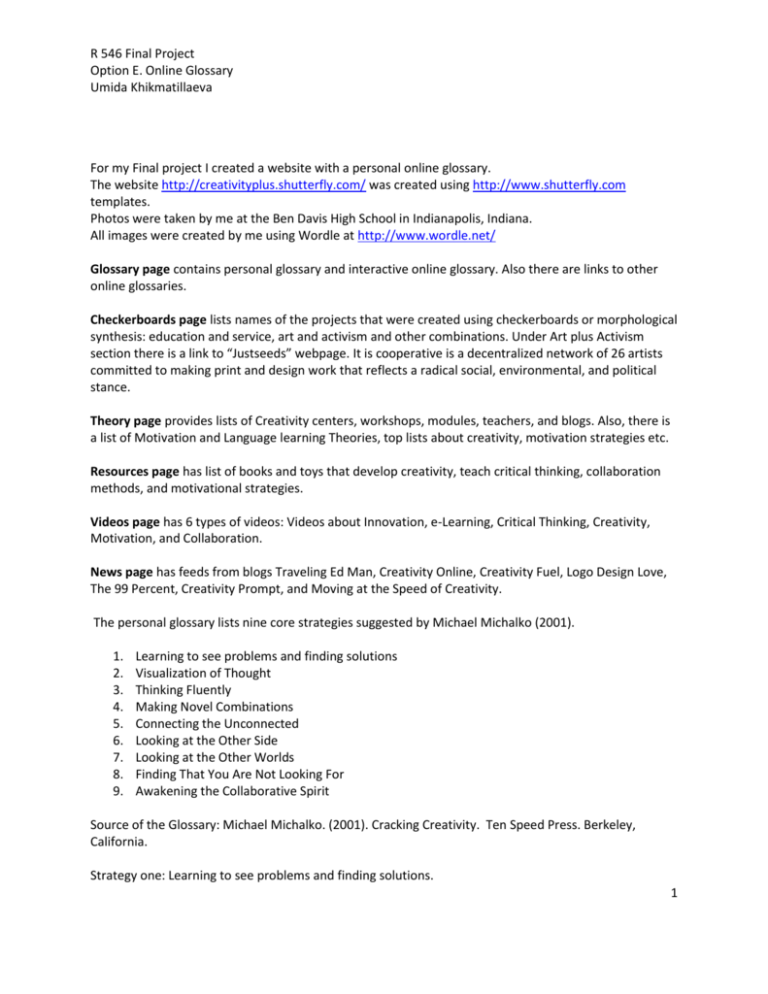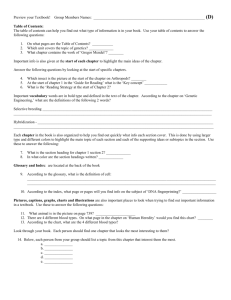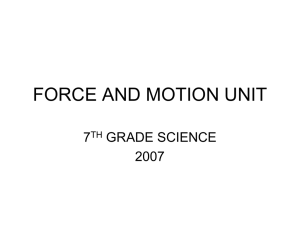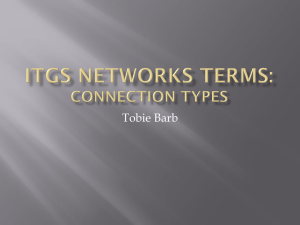R 546 Final Project Option E. Online Glossary Umida Khikmatillaeva
advertisement

R 546 Final Project Option E. Online Glossary Umida Khikmatillaeva For my Final project I created a website with a personal online glossary. The website http://creativityplus.shutterfly.com/ was created using http://www.shutterfly.com templates. Photos were taken by me at the Ben Davis High School in Indianapolis, Indiana. All images were created by me using Wordle at http://www.wordle.net/ Glossary page contains personal glossary and interactive online glossary. Also there are links to other online glossaries. Checkerboards page lists names of the projects that were created using checkerboards or morphological synthesis: education and service, art and activism and other combinations. Under Art plus Activism section there is a link to “Justseeds” webpage. It is cooperative is a decentralized network of 26 artists committed to making print and design work that reflects a radical social, environmental, and political stance. Theory page provides lists of Creativity centers, workshops, modules, teachers, and blogs. Also, there is a list of Motivation and Language learning Theories, top lists about creativity, motivation strategies etc. Resources page has list of books and toys that develop creativity, teach critical thinking, collaboration methods, and motivational strategies. Videos page has 6 types of videos: Videos about Innovation, e-Learning, Critical Thinking, Creativity, Motivation, and Collaboration. News page has feeds from blogs Traveling Ed Man, Creativity Online, Creativity Fuel, Logo Design Love, The 99 Percent, Creativity Prompt, and Moving at the Speed of Creativity. The personal glossary lists nine core strategies suggested by Michael Michalko (2001). 1. 2. 3. 4. 5. 6. 7. 8. 9. Learning to see problems and finding solutions Visualization of Thought Thinking Fluently Making Novel Combinations Connecting the Unconnected Looking at the Other Side Looking at the Other Worlds Finding That You Are Not Looking For Awakening the Collaborative Spirit Source of the Glossary: Michael Michalko. (2001). Cracking Creativity. Ten Speed Press. Berkeley, California. Strategy one: Learning to see problems and finding solutions. 1 R 546 Final Project Option E. Online Glossary Umida Khikmatillaeva Abstractions Fishbone Diagrams Words and Word Chains Rephrase the Problem Change the Words Play with Verbs and Nouns Transpose the According Michael Michalko (2001) abstraction is “a basic principle in restructuring a problem.” In other words, it is stating a problem by rephrasing it in different ways: global or specific. Specific ways of abstraction lead to quick problem solving and global abstraction first widens the problem, and then leads to finding the “missing links.” This method possibly will lead to new approaches to the problem. Methods of finding global abstraction: 1. Asking “Why?” at least 4 or 5 times. 2. Ask “In what ways might X be improved?” Specific abstraction: ask who, what, where, when, why, and how. This method is a way of visualizing a problem that allows taking consideration of all the sides. The fishbone diagram reflects and examines “all possible causes that produce an effect.” Steps: 1. Write a problem on top--make it the fish’s head. 2. Brainstorm and write major cause categories (usually three to six) into ribs of the fish. 3. Group minor causes around the ribs and make them into bones. Write solutions. 4. For each minor cause ask: “How can we make this happen?” Write responses to the minor causes as branches of bones. According to Aristotle, words and chains are powerful tools in solving problems. Words give much clearer pictures of thoughts. Ways to frame problems in words: 1. Rephrase the problem 2. Change the words 3. Play with verbs and nouns 4. Transpose the words 5. One word technique 6. Word Chain Richard Fyenman considered that using definitions to define a problem not always meaningful. He proposed that defining a problem in your own language-trying to rephrase the problem is the true knowledge. Even small change of words can have unpredictable and tragic results. Compare: “yarali”- wounded, “yararli”- useful (in Turkish). Strategy to examine a problem statement: 1. Identify the key words; 2. Change the key words to ten times to see results. Example: “In what ways might I motivate my students?” Make happy/attract/increase interest of/make more creative/excite/energize/stimulate/spark/persuade/increase learning of/inspire/lead This strategy maintains your thinking spontaneously. There are two ways of perspective change: 1. Try to change nouns with verbs. (How can I increase student enrollment versus how student enrollment can be increased?) 2. Substitute an antonym for the noun. (How can I attract students? Change “students” with “parents” and change the direction of the question: How parents can support students? What will help students to get attracted? Aristotle believed that this technique helps to achieve different perspectives. 2 R 546 Final Project Option E. Online Glossary Umida Khikmatillaeva Words One Word Technique Word Chain Positive Statements Shifting Perspective Multiple Perspectives Questions Changing order of the sentence might change your opinion, approach, and perspectives. Example: How could I advertise the event? <->How could I use the event to advertise? This technique requires following: 1. Write down your problem in one sentence and bring it into one word. 2. Replace that one word with another synonym using thesaurus. 3. Describe the meaning of the word in detail. 4. Check the dictionary to find out if there other meanings of for the word. 5. Is there better definition of the word? May some other word describe better the problem? 6. If there is one, repeat the process with the new word. 7. If there is not such word, did any explorations give you a new perspective? One word can affect another word and creative chain reaction can follow. Determine the theme of the problem and find the key word. Write it at the top of the page and then make a list of related words. After reading word list write down your reactions and comments. Look for recurring problems or issues. If the particular word raises more attention, explore it more. Positive Statement has four parts: 1. The Action: The thing you want to do. 2. The Object: A thing or person you want to change. 3. The Qualifier: The kind of action change you want. 4. The End Result: The result you expect to follow. Rate the action statement on a scale of 1 to 10. This method teaches us to look at the objects in different ways. Switching Gender: imagining oneself in opposite sex and checking if your attention and thoughts about the problem are changed. Friends and Enemies: Imagining oneself as your enemy. These methods can spark new ideas. Leonardo da Vinci’s multiple perspectives suggest examining a problem at least from three points of view: Case of the bicycle design case: inventor, bicycle rider, and municipality. Strategy: 1. Write the problem from your own point of view; 2. Write at least two more statements from different point of views that are related to the problem; 3. Synthesize the different perspectives into one single problem statement. Take on a different role: How would the center director write it? How would a department chair write it? How would a native speaker write it? How would a creative person write it? Imagine you are the problem: Imagine that you are a problem or part of it. Try to see the situation from its perspective. Think like a child: Noam Chomsky believes that his inspiration and problem solving 3 R 546 Final Project Option E. Online Glossary Umida Khikmatillaeva abilities come from asking childish questions. Playful questions: “See you problems edible. What would it taste like?” Color questions: Green, yellow, blue, and red. Green-fertility and creativity Yellow-neutral and objective Blue-hopeful and positive Red-negative Strategy Two: Visualization of Thought Diagram of Thinking Mind Mapping System mapping Visual Brainstorming Representing subjects visually by diagramming and mapping. Mind mapping is representing thoughts by key words. 1. Group Mind Mapping: combining individual mind maps. 2. Variations: try to use different variations of mind maps: print the key words to index cards and post them on the wall. 3. Picasso’s Technique: application: collect as much material as possible 4. Theme Mapping: Charles Darwin’s technique. Mapping lots of thoughts and the weeding out unrealistic/unimportant ones. 5. Lotus Blossom: Eliot’s strategy. Starting with a central theme and expanding it into subthemes and ideas. This technique helps to bring all parts into one, focusing on whole system. Graphic representations of thoughts. Diagrams, maps, 3D models, drawings, sketches, or pictures are used as brainstorming tools. Strategy Three: Thinking Fluently True-North Thinking To think fluently it is necessary to organize your thinking around a set number of principles. 1. Defer Judgment: Once an idea is judged, creative thought crystallizes and stops. 2. Possibility and Practicality Thinking: It is the raw generation of ideas. Turn off your internal critic. Practicality Thinking is useful after generating of ideas: evaluate and judge your ideas. 3. Quantity: Explore every conceivable possibility. 4. Quota: When you wish to create something new or to come up with a creative solution to a problem, it is often necessary to distance yourself from your firstborn ideas as well. 5. Listing ideas: Always write or list your ideas when brainstorming. IT is helpful tool to remember ideas and thoughts. 6. Elaborating ideas: Constantly improve your ideas and the ideas of others by 4 R 546 Final Project Option E. Online Glossary Umida Khikmatillaeva elaborating on them, adding detail, depth, and dimensions. SCAMPER Take it apart Written Records Mind Popping Nine creative thinking principles suggested by Alex Osborn. Notion: Everything new is some addition or modification of something that already exists. 1. Substitute: Things, places, procedures, people, ideas, and emotions can be substituted. It will help to develop alternative ideas to existing things. 2. Combine: combining unrelated ideas and things can yield something new. 3. Adapt: In order to think originally we must familiarize ourselves with the ideas of others. 4. Magnify: Take a subject or idea and add something to it. 5. Modify: Modify the dimensions, process, and purposes of the system. 6. Put to other uses: When context is changed, meaning also changes. 7. Eliminate: Sometimes subtracting something from the subject or idea generates something new. 8. Rearrange: IT helps to find out what we know and what we don’t know. It gives lots of variations of ideas. 9. Reverse: Look at opposites and you will see things you normally miss. Every idea is a house of many rooms. To elaborate your idea, take the problem and improve one part at a time. How many Fs in the following sentence: FINISHED FILES ARE THE RESULT OF YEARS OF SCIENTIFIC STUDY COMBINED WITH THE EXPERIENCE OF YEARS. Usually we don’t see the details of the subject. Keep a list your interesting and original ideas in a notebook, index cards, or in your computer. Leonardo and Edison had such habits. They elaborated their ideas after a long time. Keep this habit and your old ideas can lead you more complex new ideas. Mind popping is when a solution or idea seems to appear, after a long time out of nowhere. Ideas are generated in subconscious mind. The more problems, ideas, or thoughts that you record and review become more complex and networked ideas. Strategy four: Making Novel Combinations Da Vinci’s Technique He used to collect different faces and emotions and combined their elements in order to get new faces. He would list facial elements and then under each column listed their characteristics. This technique can be used in problem solving too. Procedures: 1. Specify the challenge. 2. Separate the parameters of the challenge. 5 R 546 Final Project Option E. Online Glossary Umida Khikmatillaeva Inventive Problem Solving Key Word Combinations Combining Existing Information Combining the Unrelated Combining Problems Combining Words Combine Ideas Combine Multiple Perspectives 3. Below each parameter, list as many as possible variations for the parameter. 4. When finished listing for each parameter, make random connections and examine variations. Mathematician Henri Poincare developed this technique. In this method a vast number of various combinations of possibilities are constructed, and then most likely useful solutions are selected. Procedures: 1. Select at least four parameters or dimensions. 2. List as many as possible variations for each parameter. 3. Make random combinations linking one or more variations. 4. Construct new ideas by using each random combination. 5. Try other different combinations. Fred Smith created Federal Express using three key elements: speedy messenger service, discounted jest for sale, and empty skies at night. Make a list of key words and do random combinations; sometimes it can produce unexpected and useful ideas. (Fishbowl). Organizing thoughts efficiently and systematically combining ideas, multiple solutions to the problem can be produced. The most common ways of creating novel combinations are: Random Objects: Select 20 objects at random. Make two lists of ten objects on the left and right sides of the paper. Pick one from the left and combine it with one on the right. When you find a bright idea refine and turn it into a new discovery. Combining Subjects from Unrelated Fields: when looking for unique ideas, try to combine different subjects from unrelated fields. Work on two or more unrelated problems in parallel. Shift your focus from one project to another after a while. This method can help you to see the problem from unexpected perspective. Determine the main verb and noun in the sentence (problem) and produce synonyms for them. Write them in two columns. Combine the words. You may invent something new. Combine elements of extreme ideas. Think about two opposite extreme ideas. Think about their elements and give attributes to the elements. Then try to combine them. Leonardo da Vinci believed that it might lead to explore more details about the subject. SIL: a brain writing technique. In this method multiple ideas combined and one new idea is generated. The Exquisite Corpse: a group discusses a problem and each participant writes one word on a card. Then group will combine words into one sentence. Combine Talent: dive a group according to their abilities and make them to brainstorm an idea. Then combine these ideas using SIL. Left and Right Brainers: Left-Brainers are rational thinkers and Right-Brainers are 6 R 546 Final Project Option E. Online Glossary Umida Khikmatillaeva intuitive thinkers. Make them to come up logical and illogical ideas and combine them using SIL. Strategy Five: Connecting Unconnected Techniques of Thinking Unpredictably Visuals Wishes Paper Airplanes Relational Words 1. Random Words: Make a list of random words and try to connect them. They may stimulate new associations and can become radical ideas. 2. Random Objects: Make a list of unrelated objects-imagine that you are in a famous museum and find interesting objects. Draw its picture and try to list its attributes. Relate it to your problem. 3. Thought Walk: walk whenever when you want to think and come up with new ideas. If it is a group brainstorming, ask each person to take a “thought walk” and come up with at least five things and objects. 4. Idea Bank: Get a habit of collecting interesting objects that may stimulate your imagination. They might be interesting pictures, poems, quotes, and questions. 5. Newspapers and Magazines: They are great sources for random ideas and imagination. Try to connect them to your problem. 6. You can connect anything. 7. Five senses: Write down the five senses. Select one of your ideas and try to connect it to each of the five senses. Think of a poem and try to relate a sense to the metaphoric stimulation. Picture Portfolios: Use them to brainstorm ideas. Some problems might be solved using these pictures. Children’s Drawings: Turner’s technique. Ask a child to draw a picture for you. Use these drawings to inspire your imagination and create new perspectives of the familiar places/problems. The Dreamer, the Realist, and the Critic: Walt Disney’s technique. Shift your perspective for three times, play different roles and evaluate your ideas. Most likely creative ideas come when we are wishing. Great tool for the group session. Group session technique. Make two groups write “Ideas” and “Cues.” Ask groups to construct a paper plane and fly “Cues” to each side. Group members will associate their “Ideas” to “Cues.” Paper planes can carry characteristics, components, and attributes of the problem, wishes, or absurd ideas. There are 60 basic English words that can change of relationship of elements. Use them to describe a statement Strategy six: Looking at the Other Side 7 R 546 Final Project Option E. Online Glossary Umida Khikmatillaeva Reversals Thinking paradoxically Working backward 1. Reversing Assumptions: reversals destabilize your ordinary thinking. List your assumptions and think about their opposite. 2. Reversing Perspective: Reversing the problem can help us to get picture of the problem and find effective ways to solve it. 3. Reverse Brainstorming: Using these technique ideas can be generated without judgment and criticism. 1. Paradox: Convert the problem into a paradox. Examine contraries. 2. Book Title: Summarize a paradox into a book title. Title should consist of two words: adjective and noun. The paradox will become easier to analyze. 3. Analogy, Unique Feature, Equivalent, Build into a New Idea are other techniques of thinking paradoxically. Imagine working on your problem as you are in the future. Transfer the solution back to the present and look for ways to make your idea a present day possibility. Make “the perfect cup of coffee” and think how to make it tasty. Strategy seven: Looking at the other worlds Worlds Technique World of Images 1. Parallel Worlds: This technique helps you imagine comparisons, similarities, and differences between subjects in “other worlds.” Make list of key words. 2. World of Essences: This method will expand your thinking process. 1. Determine the major principle of your problem. 2. Determine the essence of it. 3. Then describe it in as much as detail as possible. 3. World of Special Interest: Make list of words related to your hobby, discipline, or special activity. Use them to create new ideas (transfer relationships and concepts from your list to your problem. 4. The World of Nature: Take a nature walk. Ask yourself "What patterns, objects, or events in nature I can use to develop a new idea?" 5. The World of Imagination: When you relate and make connections between your subject and events or objects from you imaginary excursion, you activate more and more thought patterns. Imaginary excursion has 3 steps: Excursion, analogy, and analysis. 6. The World of Einstein: Constructing imaginary metaphorical scenarios will help to create new ideas and solve problems. 1. Pattern language: This is the language of abstract symbols that you create to substitute for words. In this method, usually the problem translated into symbols and then symbols arranged into patterns. 2. Sand Tray: This technique is to think metaphorically and by substituting physical objects for mental images. 3. Creative Collages: Metaphoric images help stimulate your thinking. Think metaphorically and analogically. Combine different images to make a whole that makes sense. 8 R 546 Final Project Option E. Online Glossary Umida Khikmatillaeva 4. Metaphor Walk: This technique helps you to look at problem in a different way. Procedure: Take 10-15 minute walk and look for objects, events, or situations that might make interesting metaphors with your subjects. Make a list of metaphors and link them to your subject. Find ways to transfer principles and try to build at least one idea or solution. 5. Photo Walk: Take your camera and take at least 5 pictures of visual metaphors. Then for each metaphor, look for new ideas and solutions. Strategy Eight: Finding That You Are Not Looking For Exploring Latent Potential Recycling Don’t Think about It Are Your Ideas Crazy Enough? Fantasy Chance Favors in Prepared Mind PMI: Plus, Minus Interesting. With the PMI, you use your intelligence to explore the subject matter. It helps you to make important decisions. Initially seen as irrelevant, old ideas can be used for creative product development. Failed idea can be combined, eliminated, and reversed and it can be latent potential for a brand new product. Any idea or subject can be recycled into something new. They just need to be modified somehow. Start with an abstract idea instead of the concrete subject. Generate several abstract ideas around the problem and consider a real problem at the end. Example: 1. Think of ways to store things. 2. Think of ways to stack things. 3. Think of ways to organize large objects. 4. Use these ideas to improve a parking garage. Think in unstructured way. Sometimes there are interesting and strange events that might inspire you. Procedure: 1. Think about absurd or crazy ideas about your problem. 2. Choose one of them. 3. Determine the principle. 4. Make a list of features and aspects of the absurd idea. 5. Choose one of the features and think about a practical idea. Fantasy Envelopes: 1. Divide group into three teams. Each team gets an envelope with one of the three questions. 2. Each team writes an idea or answer on the outside of the envelope then passes it to the other team. Each team generates specific solutions. 3. Solutions are discussed and evaluated at the end. Crossbreeding Subjects: Crossbreed two subjects from two different worlds. Construct new identity. Opportunity Headlines: Think about interesting demographic, social, technological or economic facts or trends. Write one fact on one card. Then put them in order to form headlines. Chance arrangements: Think about different facts and trends. Write one fact on one card. Shuffle them and build a new idea. Strategy Nine: Awakening the Collaborative Spirit 9 R 546 Final Project Option E. Online Glossary Umida Khikmatillaeva The Spirit of Koinonia Participants Suspending all assumptions Group Brainstorming Techniques Storyboarding Three principles are known as "Koinonia"- "spirits of fellowship." 1. Establish dialog. 2. Clarify your thinking. 3. Be honest. Have diverse group members: experts, non-experts, and people from different fields. Suspending judgment. Environment. Playfulness. Having facilitator. Stating the problem. Idea production. Elaboration. Clarifying Thinking. Recording. Evaluation. 2. Brain writing: Distribute stimulation cards and make each person to write some idea on it. At the end post them on the wall. Evaluate ideas. 3. Idea Pool: Each person generates idea and writes it on the index card. When other participant needs an idea, they exchange ideas from the pool. 4. Gallery: Post paper or sticky notes on the wall. Allow participants to walk around the “gallery” and find new ideas. 5. Three Plus: Each participant writes three ideas on the top of sheets of paper, one idea per sheet. They are passed to group members and everyone writes an idea, solution, or thought to improve the initial idea. 6. Airplanes: Each participant constructs a paper plane and writes an idea on it. Each participant will fly airplanes in order to improve and modify ideas. 7. Notebooks: 1. Each participant will get notebook containing problem information and instructions. The participants will write at least three ideas per day and exchange notebooks every week. Participants will exchange ideas for four weeks. 8. Open Meetings: A meeting open for all employees. There is no agenda for the meeting. All issues posted on the wall. Issues are discussed and evaluated. 9. KJ Brainstorming, NHK, Two-week Brainstorming, Mixed Sessions, Clustering, and Wall of Ideas are other group brainstorming techniques. 1. Post the topic card on the wall. 2. Determine purpose of the topic. 3. Identify headers- major issues. 4. Add miscellaneous header. 5. Brainstorm ideas. Make group members to write ideas, solutions, and thoughts. Keep the storyboard flexible and dynamic. 6. Incubate ideas for a few days or weeks. 7. Use different materials to create and post your storyboard. 10







